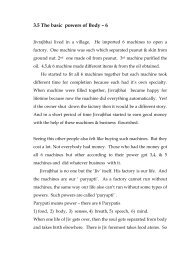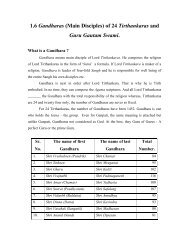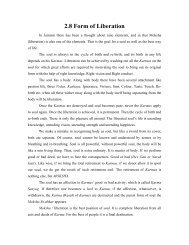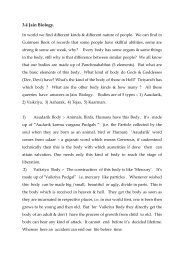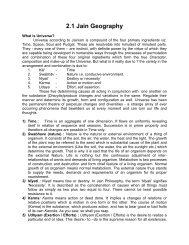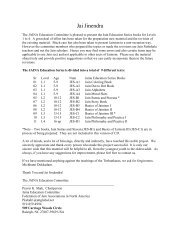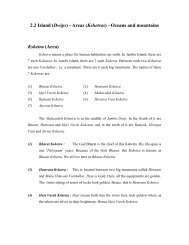Paryushan Parva - Jainism, Jain Religion - colleges
Paryushan Parva - Jainism, Jain Religion - colleges
Paryushan Parva - Jainism, Jain Religion - colleges
You also want an ePaper? Increase the reach of your titles
YUMPU automatically turns print PDFs into web optimized ePapers that Google loves.
Sämäyik in English with Meaning<br />
State of Equanimity<br />
Logassa Sutra is the Chaturvimshati-Stav. By reciting Logassa Sutra with true feelings, one purifies<br />
the beliefs, and attains the right perception. One who has the right perception attains Moksha in<br />
relatively short time. By praising the qualities of Tirthankars, the passions are subdued.<br />
3. Vandanä - Respecting and saluting ascetics. In absence of Thirthankar, our true teachers are our<br />
<strong>Jain</strong> Ächaryas 7 , Upädhyäyas 8 and Sädhus, who show us the path of liberation. They are the<br />
practitioners of the true path of salvation. By paying respect to the true <strong>Jain</strong> monks and nuns, one<br />
wins over his/her egos, and develops the quality of humility (vinay). This process subdues our<br />
passions, and helps us advance spiritually,<br />
4. Pratikraman - Reviewing our daily activities, and concentrating on retreating from them.<br />
Pratikraman is the best of all six Ävashyaka (essential rites). "Prati" means "back" and "kraman"<br />
means "to go", i.e. to go back, review, confess, and repent the bad thoughts and deeds from our<br />
daily, nightly, biweekly, quarterly and yearly activities. It also means going back to the path of<br />
nonviolence, truthfulness, non-stealing, celibacy and non-attachment, and forgiving the faults of<br />
others, asking forgiveness for our faults without any reservation, and extending friendship. This will<br />
stop (Samvara) the influx (Äsrava) of karma that cover the true nature of our soul (self, jiva, or<br />
ätmä) which has the qualities of perfect knowledge, vision, bliss, and power. It means to disengage<br />
from non-soul like activities, and to engage in the soul-like activities. Pratikraman is like a mirror.<br />
We see our selves, externally, in mirror the way it is. During Pratikraman, we see our selves,<br />
internally, the way it is. We see our faults, and wrong doings. We ask for forgiveness for all<br />
wrongful acts, and take vows to minimize such acts.<br />
5. Käyotsarga - Stopping attachments to the body, and tuning with yourself. The main reason for<br />
our misery is that, since the beginningless time (Anädi-käl) we have been considering our body as<br />
our self, not the soul. This process of Käyotsarga involves, making all non-soul items like body,<br />
mind and emotions as steady as possible so that one can concentrate on and experience that the soul<br />
is different than the body. This process helps reduce the attachment to the material things. This<br />
gives the experience that our self is our soul.<br />
6. Pratyäkhän/Pachchhakhän - Renouncing certain activities for some time to discipline one's self.<br />
To take vows according to one’s capabilities, to disengage from foreign substances and to engage in<br />
the self-substance. The Shrävaks take partial vows, and ascetics take the great vows.<br />
Spiritual Meanings Behind the Items Used in Sämäyik n<br />
Charavalo: is used to gently clean the floor (to make the space free of subtle<br />
living beings). It also allows the aspirant to move when it is necessary during<br />
the Sämäyik or Pratikraman. Its spiritual meaning is to remind us that we<br />
need to clean our soul of all karma particles. It reminds us of non-violence. Its<br />
stick is 24 fingers tall and it reminds us that we have been punished 24<br />
different ways (24 Dandank, essentially expansion of four destinies) because<br />
7 The message of Jina, Lord Mahavir, the last Tirthankar, is carried by the Ächäryas, the spiritual leaders. The<br />
responsibility of the spiritual well being of the entire <strong>Jain</strong> Sangh rests on the shoulders of the Ächäryas. Before reaching<br />
that state, one has to do an in-depth study and gain mastery over the Ägams. In addition to acquiring a high level of<br />
spiritual excellence, they also have the ability to lead the monastic communion. They should also know various<br />
languages of the country and have a sound knowledge of other philosophies, ideologies, and religions of the region and<br />
of the world.<br />
8 The title of Upädhyäya is given to those Sädhus who have acquired a special knowledge of the Ägams (<strong>Jain</strong> scriptures)<br />
and philosophical systems. They teach <strong>Jain</strong> scriptures to deserving aspirants, including Sädhus and sädhvis.<br />
5




